| ________________
CM . . .
. Volume XIX Number 13. . . .November 30, 2012 
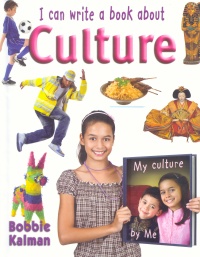 |
I Can Write a Book About Culture. (I Can Write a Book Series).
Bobbie Kalman.
St. Catharines, ON: Crabtree, 2012.
32 pp., pbk. & hc., $9.95 (pbk.), $20.76 (RLB.).
ISBN 978-0-7787-7998-8 (pbk.), ISBN 978-0-7787-7989-6 (RLB).
Subject Headings:
Culture-Juvenile literature.
Composition (Language arts)-Juvenile literature.
English language-Composition and exercises-Juvenile literature.
Book design-Juvenile literature.
Grades 3-5 / Ages 8-10.
Review by Gail Hamilton.
*1/2 /4
|
| |
|
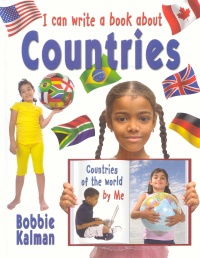 |
I Can Write a Book About Countries. (I Can Write a Book Series).
Bobbie Kalman.
St. Catharines, ON: Crabtree, 2012.
32 pp., pbk. & hc., $9.95 (pbk.), $20.76 (RLB.).
ISBN 978-0-7787-7997-1 (pbk.), ISBN 978-0-7787-7988-9 (RLB).
Subject Headings:
Geography-Authorship-Juvenile literature.
Composition (Language arts)-Juvenile literature.
English language-Composition and exercises-Juvenile literature.
Book design-Juvenile literature.
Grades 3-5 / Ages 8-10.
Review by Gail Hamilton.
*1/2 /4
|
| |
|
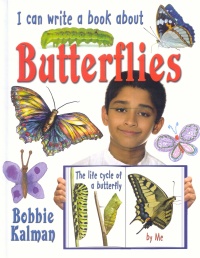 |
I Can Write a Book About Butterflies. (I Can Write a Book Series).
Bobbie Kalman.
St. Catharines, ON: Crabtree, 2012.
32 pp., pbk. & hc., $9.95 (pbk.), $20.76 (RLB.).
ISBN 978-0-7787-7997-1 (pbk.), ISBN 978-0-7787-7988-9 (RLB).
Subject Headings:
Butterflies-Juvenile literature.
Biology-Authorship-Juvenile literature.
Composition (Language arts)-Juvenile literature.
English language-Composition and exercises-Juvenile literature.
Book design-Juvenile literature.
Grades 3-5 / Ages 8-10.
Review by Gail Hamilton.
*1/2 /4
|
| |
|
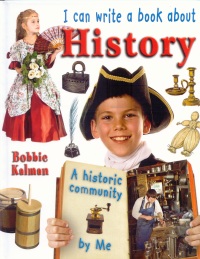 |
I Can Write a Book About History. (I Can Write a Book Series).
Bobbie Kalman.
St. Catharines, ON: Crabtree, 2012.
32 pp., pbk. & hc., $9.95 (pbk.), $20.76 (RLB.).
ISBN 978-0-7787-7999-5 (pbk.), ISBN 978-0-7787-7990-2 (RLB).
Subject Headings:
Historiography-Juvenile literature.
Composition (Language arts)-Juvenile literature.
English language-Composition and exercises-Juvenile literature.
Book design-Juvenile literature.
Grades 3-5 / Ages 8-10.
Review by Gail Hamilton.
*1/2 /4
|
| |
|
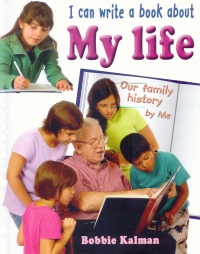 |
I Can Write a Book About My Life. (I Can Write a Book Series).
Bobbie Kalman.
St. Catharines, ON: Crabtree, 2012.
32 pp., pbk. & hc., $9.95 (pbk.), $20.76 (RLB.).
ISBN 978-0-7787-8002-1 (pbk.), ISBN 978-0-7787-7993-3 (RLB).
Subject Headings:
Autobiography-Authorship-Juvenile literature.
Biography as a literary form-Juvenile literature.
Composition (Language arts)-Juvenile literature.
English language-Composition and exercises-Juvenile literature.
Book design-Juvenile literature.
Grades 3-5 / Ages 8-10.
Review by Gail Hamilton.
*1/2 /4
|
| |
|
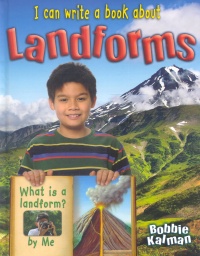 |
I Can Write a Book About Landforms. (I Can Write a Book Series).
Bobbie Kalman.
St. Catharines, ON: Crabtree, 2012.
32 pp., pbk. & hc., $9.95 (pbk.), $20.76 (RLB.).
ISBN 978-0-7787-8001-4 (pbk.), ISBN 978-0-7787-7992-6 (RLB).
Subject Headings:
Landforms-Juvenile literature
Geography-Authorship-Juvenile literature.
Composition (Language arts)-Juvenile literature.
English language-Composition and exercises-Juvenile literature.
Book design-Juvenile literature.
Grades 3-5 / Ages 8-10.
Review by Gail Hamilton.
*1/2 /4
|
| |
|

excerpt:
A font is a style of type. Plain text font is the font used for the body of this book. For special features in the book, other kinds of fonts are also used. Boldface is a thick black font used for words that may be new to you. Sometimes these words are explained where they appear in the book, and sometimes they are defined in the glossary. The headings and subheadings stand out from the rest of the text by being in a different font, in larger sizes, and in color. For your heading fonts, choose colors that match the pictures on the pages. (From I Can Write a Book about Countries.)
Part of the eight-volume "I Can Write a Book" series, these titles, averaging 15 chapters each, are designed to teach children how to write nonfiction books about a variety of topics. All of the books contain basically the same information (and, often, not even paraphrased, but having identical wording), the only differences being the topics and the tips for generating ideas about them. For example, if a student were to write a book about butterflies, the book would likely include information about the insect's body, life cycle and migration patterns, while writing a book about history would require budding authors to narrow their focus to a specific time in history and use different resources for fact-finding, and, perhaps even to visit a museum or an old fort or village in order to get some ideas.
Following a general introduction, Kalman explains the parts of a nonfiction book- the cover, title page, copyright page, table of contents, glossary and index- then provides some "big ideas" about the featured topic to get kids thinking about the focus of their book. She shares her personal method of getting inspiration and suggests that kids should draw pictures of the topic or cut pictures out of magazines to get them excited about writing. Kalman then tells readers how to conduct research (actually, she merely lists a few possible sources, such as books, encyclopedias and the Internet- who uses encyclopedias these days?) and take notes; however, she doesn't really offer any tips about note-taking and simply states that students should first read and understand the information and then write it down in their own words. Students are encouraged to make an outline and divide their book into sub-headings (Kalman suggests that double-page spreads are the way to go, because they automatically divide the topic into short chapters). Choosing different font styles and colours and using catchy phrases for photo captions will add to the book's appeal, as might the inclusion of fact boxes which provide information that the young author would like to highlight. Other topics in these titles are editing, revising, design (adding photos, maps and diagrams and presenting them in an aesthetically pleasing layout) and publishing (which Kalman defines as sharing one's book with others). Kalman also discusses different writing styles: informational text, instructional text, descriptive text and narrative text. Some of the chapters provide checklists so that students can analyze their writing and revise accordingly, and a fact box entitled "Bobbie's tip" offers a helpful hint. Colour photographs (several of which are of Bobbie Kalman herself) and diagrams enhance the text. At the back of each title are several photos of other Crabtree books which are related to the topic and which can be used as resources.
The titles in this series have several flaws. Firstly, the books are almost identical with regard to the writing process, and so purchasing one book would suffice. Changing the topic would simply require a bit of adaptation in terms of generating ideas and sub-headings. Secondly, there is an inconsistency in the difficulty of the vocabulary amongst the titles. For instance, the key words in the book about butterflies are much easier to read than those in the books about landforms and history. Thirdly, many of the photos are repeated throughout the series. Fourthly, there is still a need, on the part of the classroom teacher or parent, to do some teaching, as Kalman assumes that all readers know how to alphabetize lists, access appropriate information online, and use a dictionary well. Fifthly, Kalman encourages readers to write narrative pieces and to express their emotions. Would this not confuse kids when they are learning how to write nonfiction? The most significant flaw, however, is Kalman's view that teaching kids how to write is best done via one of her books (and she prides herself on having written over 800 nonfiction books). As a former teacher, herself, she should know that the art of teaching writing to youngsters is best left to teachers, who, over a period of time, will expose their students to examples of excellent works of nonfiction and who will guide their students through a series of developmental stages in order to have them create their own books. Writing, like sports, is best done by doing, not by reading about it.
Though there is some good information in these titles, there are several omissions and vague explanations. It is highly doubtful that kids will pick these books up voluntarily. Those students who like to write will do so without the benefit of Kalman's tutelage.
Not recommended.
Gail Hamilton is a former teacher-librarian in Winnipeg, MB.

To comment
on this title or this review, send mail to cm@umanitoba.ca.
Copyright © the Manitoba Library Association. Reproduction for personal
use is permitted only if this copyright notice is maintained. Any
other reproduction is prohibited without permission.
NEXT REVIEW |
TABLE OF CONTENTS FOR THIS ISSUE
- November 13, 2012.
AUTHORS |
TITLES |
MEDIA REVIEWS |
PROFILES |
BACK ISSUES |
SEARCH |
CMARCHIVE |
HOME |





